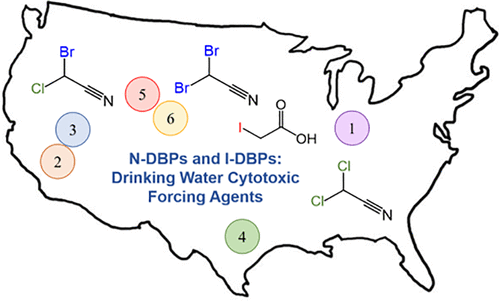
Hi all…there have been a number of interesting papers being published recently. One asks a question that has probably crossed all of our minds before, “should other DBPs be considered for regulation?” My thought was that as long as THMs and/or HAAs were “reasonable” surrogates for other DBPs then there is less pressure to add other classes of DBPs, or replace THMs outright. That said, there has been evidence for quite some time to suggest that other DBPs are associated with toxicity. The authors acknowledge this stating “currently, epidemiologists employ THMs as a metric for DBP exposure based on the assumption that THM concentrations are proportional to concentrations of other DBP classes. However, toxicological data have repeatedly indicated that THMs are less potent toxins than unregulated DBP classes, such as the HANs. Since THMs are not proportional to the DBPs driving toxicity, the use of THMs to measure exposure introduces exposure misclassification bias in epidemiologic studies.” While the paper doesn’t outright propose that THMs be replaced, it does conclude that “haloacetonitriles and iodoacetic acids should be prioritized in future research for potential regulation consideration.”
While it was not noted in the abstract the study found “surprisingly, raw water from the plant influents before disinfection, where no DBPs were present, was higher in cytotoxicity than the disinfected water in many cases.” The authors follow-up by stating “although it is unclear what specific compounds are driving raw water cytotoxicity, these data highlight the importance of protecting source waters and the need for water treatment procedures to remove cytotoxic contaminants. Moreover, the raw water cytotoxicity puts the toxicity of DBPs in perspective, as the overall impact of treatment and disinfection often produced a finished water lower in cytotoxicity than the raw water.”
Bill _________________________________________________________________
Drivers of Disinfection Byproduct Cytotoxicity in U.S. Drinking Water: Should other DBPs be Considered for Regulation?
Joshua M. Allen, Michael J. Plewa, Elizabeth D. Wagner, Xiao Wei, Katherine Bokenkamp, Kyu Hur, Ai Jia, Hannah K. Liberatore, Chih-Fen T. Lee, Raha Shirkhani, Stuart W. Krasner, and Susan D. Richardson
Environ. Sci. Technol. 2022, 56, 1, 392–402 Publication Date: December 15, 2021 https://doi.org/10.1021/acs.est.1c07998
Abstract
“This study reveals key disinfection byproduct (DBP) toxicity drivers in drinking water across the United States. DBPs, which are ubiquitous in drinking water, form by the reaction of disinfectants, organic matter, bromide, and iodide and are generally present at 100–1000× higher concentrations than other contaminants. DBPs are linked to bladder cancer, miscarriage, and birth defects in human epidemiologic studies, but it is not known as to which DBPs are responsible. We report the most comprehensive investigation of drinking water toxicity to date, with measurements of extracted whole-water mammalian cell chronic cytotoxicity, over 70 regulated and priority unregulated DBPs, and total organic chlorine, bromine, and iodine, revealing a more complete picture of toxicity drivers. A variety of impacted waters were investigated, including those impacted by wastewater, agriculture, and seawater. The results revealed that unregulated haloacetonitriles, particularly dihaloacetonitriles, are important toxicity drivers. In seawater-impacted water treated with chloramine, toxicity was driven by iodinated DBPs, particularly iodoacetic acids. In chlorinated waters, the combined total organic chlorine and bromine was highly and significantly correlated with toxicity (r = 0.94, P < 0.01); in chloraminated waters, total organic iodine was highly and significantly correlated with toxicity (r = 0.80, P < 0.001). These results indicate that haloacetonitriles and iodoacetic acids should be prioritized in future research for potential regulation consideration.”





